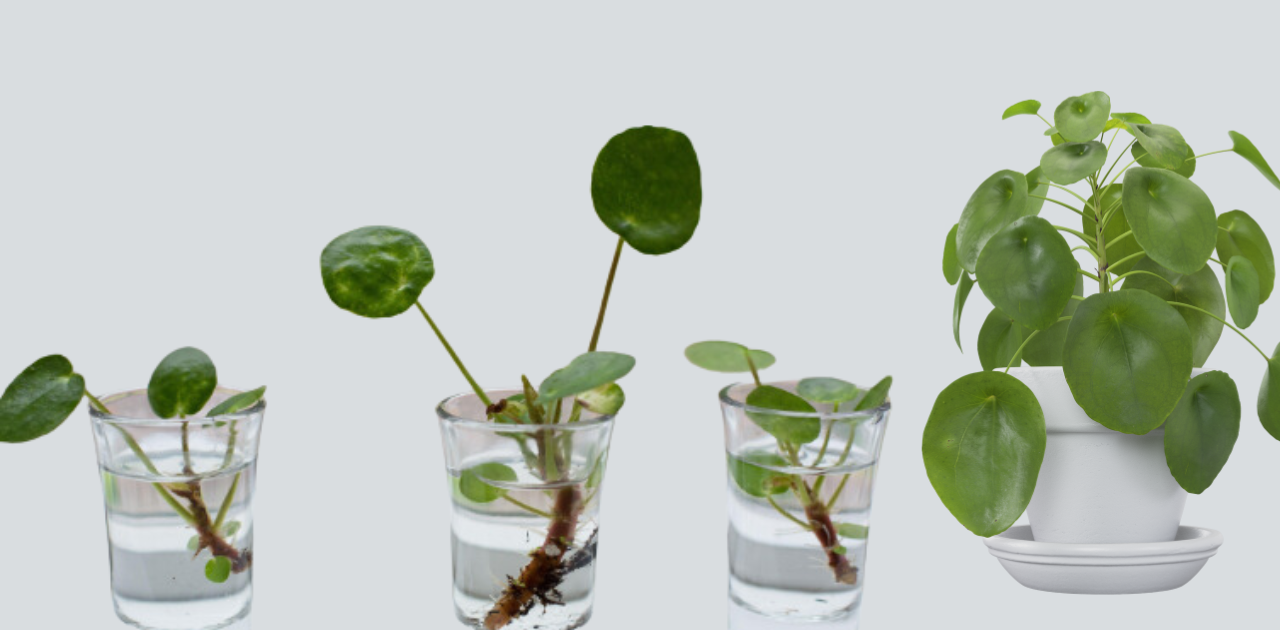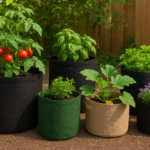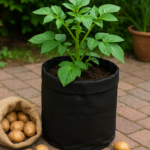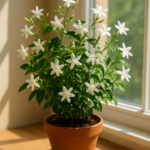Propagating the Chinese Money Plant, also known as Pilea peperomioides, is a rewarding process that allows you to expand your plant collection effortlessly. With its distinctive round leaves and easy-care nature, this charming plant is perfect for novice and seasoned gardeners. You can successfully propagate your Chinese Money Plant by learning the proper techniques and creating new plants to decorate your home or gift to friends. Propagation is cost-effective and incredibly satisfying as you watch a new plant grow from a small cutting into a thriving specimen.
In this guide, we will explore various propagation methods, essential tools, and materials and provide step-by-step instructions to ensure your propagation efforts succeed. Get ready to embark on a fun and fulfilling gardening adventure!
About the Chinese Money Plant

Botanical Background
The Chinese Money Plant, scientifically known as Pilea peperomioides, belongs to the Urticaceae family. This perennial plant is native to the Yunnan Province in southern China, where it thrives in the subtropical climate. Pilea peperomioides is characterized by its unique coin-shaped leaves, which are glossy, deep green, and grow on long, slender stems. The plant typically reaches a height of about 12 inches, making it a perfect choice for indoor gardening. Its easy-going nature and low maintenance requirements have made it popular among houseplant enthusiasts worldwide.
Read to know more: Can Money Plant Grow in Aquarium? With tips
Common Names and Origin
The Chinese Money Plant is known by several common names, reflecting its widespread appeal and diverse history. It is often called the Pancake Plant due to the flat, round shape of its leaves or the UFO Plant because of its somewhat otherworldly appearance. Another popular name is the Missionary Plant, a nod to its introduction to the West by Norwegian missionary Agnar Espegren in the mid-20th century. Espegren is credited with bringing the plant from China to Europe, where it quickly gained popularity and became a beloved houseplant in many homes.
| Aspect | Details |
| Scientific Name | Pilea peperomioides |
| Family | Urticaceae |
| Common Names | Chinese Money Plant, Pancake Plant, UFO Plant, Missionary Plant |
| Popularity | Beloved houseplant know |
| Historical Introduction | Introduced to the West by Norwegian missionary Agnar Espegren in the mid-20th century |
| Propagation Methods | Stem cuttings, leaf cuttings, division |
| Ideal Temperature | Thrives in temperatures between 60-75°F (16-24°C) |
| Watering Needs | Allow the soil to dry slightly between waterings; avoid overwatering |
| Light Requirements | Prefers bright, indirect light |
Importance of Chinese Money Plant
The Chinese Money Plant, or Pilea peperomioides, is more than just a visually appealing houseplant; it holds significant cultural and ecological value. Known for its distinctive round leaves that resemble coins, this plant is often associated with good fortune and prosperity in many cultures. Its compact size and striking appearance make it a popular choice for interior decoration, adding a touch of greenery to homes and offices. Beyond aesthetics, the Chinese Money Plant is incredibly low-maintenance, making it ideal for busy individuals or those new to gardening. Its ability to purify air by removing toxins also contributes to a healthier living environment, enhancing physical and mental well-being.
Benefits of Propagation

Propagating the Chinese Money Plant offers numerous benefits, making it a rewarding endeavor for plant enthusiasts. Here are some key advantages:
- Cost-Effective Gardening: Propagating your plants allows you to expand your collection without incurring additional costs. This method also allows you to create new plants from existing ones, maximizing your investment.
- Gifting Opportunities: Propagated plants make thoughtful and personalized gifts. Sharing a piece of your plant adds a special touch, and it’s a great way to introduce friends and family to the joys of gardening.
- Sustainability: Propagation reduces the demand for commercially grown plants, which often require significant resources to produce and transport. By propagating at home, you contribute to more sustainable gardening practices.
- Learning Experience: Propagation provides a hands-on learning experience, helping you understand plant biology and growth cycles. This knowledge can be applied to other plants, enhancing your overall gardening skills.
- Increased Plant Health: Regular propagation can encourage the parent plant to grow more vigorously, stimulating new growth. This can lead to a healthier, more robust plant.
- Decorative Variety: With multiple plants, you can experiment with different placements and arrangements, enhancing the aesthetic appeal of your living space. Multiple Chinese Money Plants can create a cohesive and lush indoor garden.
Why Propagate Chinese Money Plant?
Propagating the Chinese Money Plant (Pilea peperomioides) is a rewarding and practical activity for plant lovers. Here are several compelling reasons to propagate this delightful plant:
Cost-Effective Gardening
Propagation allows you to expand your collection of Chinese Money Plants without purchasing additional plants. Cuttings from your existing plants can be used to grow new ones at no extra cost, making propagation an economical way to enhance your indoor garden.
Gifting Opportunities
Propagated plants make wonderful, heartfelt gifts. Giving someone a Chinese Money Plant you have propagated yourself adds a personal touch and a story behind the gift. It’s a perfect way to share your love for gardening with friends and family and introduce them to the joy of caring for plants.
Personal Satisfaction
Propagating plants brings a deep sense of fulfillment. Watching a cutting develop roots and grow into a healthy plant is immensely satisfying. It’s a testament to your care and attention, providing a tangible reward for your efforts.
Promoting Plant Health
Regular propagation can benefit the parent plant. By trimming and taking cuttings, you encourage new growth, which can result in a bushier and more vigorous plant. This practice helps maintain your Chinese Money Plant’s overall health and aesthetic appeal.
Sustainability
Propagation supports sustainable gardening practices. Instead of buying new plants that have been commercially grown and transported, you can create new plants at home. This reduces the environmental impact associated with mass-produced plants and promotes a more eco-friendly approach to gardening.
Decorative Versatility
Having multiple Chinese Money Plants allows you to experiment with different placements and arrangements in your home. You can create a cohesive look by grouping them or spreading them throughout your space for a consistent touch of greenery.
Educational Value
Propagation is a fantastic way to learn about plant biology and growth cycles. It provides hands-on experience and deepens your understanding of how plants reproduce and thrive. This knowledge can be applied to other plants in your collection, making you a more skilled and confident gardener.
Best Time to Propagate
When it comes to propagating your Chinese Money Plant (Pilea peperomioides), timing can significantly impact the success of your efforts. Here’s what you need to know about the best time to propagate this popular houseplant:
the ideal times to propagate Chinese Money Plants

Spring and Early Summer: Spring and early summer are the ideal times to propagate Chinese Money Plants. During these seasons, the plant enters its active growth phase, which means it has more energy for developing new roots and shoots. The warmer temperatures and increased daylight hours create optimal conditions for propagation, enhancing the chances of success.
Avoid Late Fall and Winter: It’s generally best to avoid propagating during late fall and winter. During these cooler months, the plant’s growth slows down and enters a more dormant state. This dormancy period means the plant has less energy to support the development of new roots, making propagation more challenging and less likely to succeed.
Ideal Growth Conditions
Healthy Parent Plant: Before propagating, ensure your plant is healthy and thriving. A robust, well-cared-for plant is more likely to produce successful cuttings. Look for signs of good health, such as vibrant green leaves, strong stems, and no signs of pests or disease.
Adequate Light: Provide your Chinese Money Plant with plenty of bright, indirect light. Good lighting conditions will help the parent plant and the cuttings grow more effectively. While the plant can tolerate lower light conditions, optimal light will encourage more vigorous growth and root development.
Consistent Temperature: Maintain a stable and warm environment for your plant. Chinese Money Plants prefer temperatures between 60-75°F (16-24°C). Avoid exposing the plant to drafts or sudden temperature changes, which can stress the plant and negatively impact propagation efforts.
Proper Watering: Ensure your plant is well-hydrated before taking cuttings. Water the parent plant thoroughly a day before propagation to ensure optimal conditions. However, avoid overwatering, as waterlogged soil can lead to root rot and other issues.
Methods of Propagation
The Chinese Money Plant (Pilea peperomioides) can be developed using several methods. Each method has its unique advantages and processes. Here are the most common methods:
Stem Cuttings
Stem cuttings are one of the easiest and most reliable ways to propagate Chinese Money Plants. This method involves taking a piece of the plant’s stem to develop roots and grow into a new plant.
Leaf Cuttings
Although less common and more challenging, leaf cuttings can also be used to propagate Chinese Money Plants. This method involves using individual leaves to generate new plants.
Division
The division is ideal for mature plants that have produced offshoots or “pups” at their base. This method involves separating these offshoots from the parent plant and replanting them.
Tools and Materials Needed
Essential Gardening Tools
- Sharp scissors or a knife: For clean cuts without damaging the plant.
- Small pots or containers: For planting new cuttings.
- Watering can or spray bottle: To keep the soil moist.
- Plastic bags or propagation domes: To maintain humidity around the cuttings.
Necessary Materials for Propagation
- Potting mix: A well-draining soil mix, ideally one designed for succulents or houseplants.
- Rooting hormone (optional): To encourage faster root development.
- Clean water: For watering and rooting cuttings.
Step-by-Step Guide to Propagation
Preparing the Parent Plant
- Choose a Healthy Plant: Ensure the parent plant is free from pests and diseases.
- Water Thoroughly: Water the plant a day before taking cuttings to ensure it’s well-hydrated and ready for propagation.
Taking Cuttings
- Select a Stem or Leaf: Choose a healthy stem or leaf for cutting. Select stems at least 4-6 inches long with a few leaves for stem cuttings. For leaf cuttings, choose mature, healthy leaves.
- Make the Cut: Use sharp scissors or a knife to make a clean cut just below a node for stem cuttings or with a small section of stem attached for leaf cuttings.
Rooting Process
- Apply Rooting Hormone (Optional): Dip the cut end in rooting hormone to promote root growth.
- Plant the Cutting: Place the stem or leaf cutting in a small pot filled with moist potting mix. Ensure the cuttings are planted at a depth where they can stand upright.
- Maintain Humidity: Cover the pot with a plastic bag or propagation dome to create a humid environment. This helps prevent the cuttings from drying out and encourages root development.
Potting the New Plants
- Check for Roots: After a few weeks, gently tug the cuttings to see if they have developed roots. Rooted cuttings will resist being pulled out.
- Transplant: Once roots have been established, transplant the cuttings into larger pots with fresh potting mix. Water thoroughly and place them in a bright, indirect light location.
from Stem Cuttings
- Select Healthy Stems: Choose stems that are healthy and free from damage.
- Cut Below a Node: Make a clean cut below a node (where the leaf joins the stem).
- Rooting: Place the cut end in water or directly into a moist potting mix. If rooting in water, change the water every few days.
Propagating from Leaf Cuttings
- Choose Healthy Leaves: Select mature, healthy leaves.
- Cut with a Stem Section: Ensure a small stem section is attached to the leaf.
- Planting: Insert the leaf into a moist potting mix and maintain high humidity.
Propagating by Division
- Separate Offshoots: Gently separate the offshoots from the parent plant, ensuring each has some roots attached.
- Replant Offshoots: Plant the divisions in individual pots with fresh potting mix.
How Do I Know If My Cutting Is Successful?
When propagating a Chinese Money Plant (Pilea peperomioides) or any other plant, monitor the progress to ensure the successful propagation process. Here’s how to determine if your cutting has taken root and is thriving:
- Root Development:
- Visual Inspection: Check the potting mix or container where the cuttings are placed. After a few weeks, gently tug the cuttings to see if they resist being pulled out. If the cuttings feel firm and rooted in place, it’s a good sign they’ve developed roots.
- Water Propagation: If you’re propagating cuttings in water, observe the roots forming. Healthy roots should start to appear and grow over time.
- New Leaf Growth:
- Healthy New Leaves: When the cutting develops new leaves, the cutting has successfully taken root and is growing.
- Overall Vigor:
- Appearance of Growth: Check the overall appearance of the plant. The cutting is likely thriving if it looks healthy, with vibrant green leaves and robust stems.
- Watering and Moisture:
- Healthy Root System: The cutting should be able to absorb water effectively. If the soil or water conditions remain moist and healthy, it’s a sign that the plant is growing successfully.
Common Problems and Solutions
When caring for a Chinese Money Plant (Pilea peperomioides), you might encounter a few common issues that can impact its health. Here are some common problems and solutions:
Root Rot
Problem: Root rot occurs when the plant is overwatered, causing the roots to remain in waterlogged soil for an extended period. This can lead to the roots becoming mushy and black, affecting the plant’s overall health.
Solution:
- Reduce Watering: Adjust your watering schedule to allow the soil to dry out slightly between watering. Chinese Money Plants prefer slightly drier soil conditions.
- Improve Drainage: Ensure the pot has drainage holes to prevent water from accumulating at the bottom.
- Check for Healthy Roots: Gently remove the plant from its pot to inspect the roots. Cut off damaged or rotten roots and repot the plant in fresh, well-draining soil.
Pest Control
Problem: Pests such as spider mites, aphids, or mealybugs can infest the Chinese Money Plant, damaging its leaves and hindering its growth.
Read to know About:Do Houseplants Attract Bugs? Thriving Indoors
Solution:
- Natural Remedies: Wash the leaves gently with a mild water solution and mild dish soap to remove pests. Rinse thoroughly to ensure no soap residue remains.
- Insecticidal Soap: If natural remedies are ineffective, consider using an insecticidal soap to treat the affected plant.
- Isolation: Quarantine the plant away from other plants until the pest problem is resolved to prevent spreading.
Yellowing Leaves
Problem: Yellowing leaves can be caused by various factors, such as overwatering, underwatering, improper light, nutrient deficiencies, or pest infestations.
Solution:
- Adjust Watering Schedule: Ensure the plant’s soil is allowed to dry out slightly between watering. If the plant is too dry, increase watering, and if overwatered, reduce watering and let the soil dry out.
- Check Light Conditions: Ensure the plant is placed in a location with adequate, indirect light. Too much direct sunlight can scorch the leaves, and too little light can cause them to turn yellow.
- Nutrient Supplementation: Consider using a balanced fertilizer to give the plant essential nutrients. Follow package instructions to avoid over-fertilizing, which can also harm the plant.
- Inspect for Pests: Check for any pest infestations that could be causing stress and affecting the plant’s health.
FAQs
- How often should I water my Chinese Money Plant?
- Water your Chinese Money Plant when the top inch of the soil feels dry to the touch. Allowing the soil to dry out slightly between watering sessions is essential. Overwatering can lead to root rot.
- What kind of light does a Chinese Money Plant prefer?
- Chinese Money Plants thrive in bright, indirect light. They can tolerate low light conditions but may not grow as vigorously. Avoid placing them in direct sunlight, as it can scorch the leaves.
- Can I propagate my Chinese Money Plant in water?
- Yes, you can propagate Chinese Money Plants in water. Place the cuttings in a jar with water, ensuring the water level stays below the node or leaf. Once roots develop, transplant the cutting into the potting mix.
- How long does it take for a cutting to root?
- It typically takes about 2-4 weeks for roots to develop on a cutting, depending on environmental conditions such as temperature, humidity, and light.
- What should I do if my Chinese Money Plant has yellowing leaves?
- Yellowing leaves can be due to several reasons, including overwatering, underwatering, nutrient deficiencies, or pests. Adjust watering schedules, inspect for pests, and provide adequate light to see if it resolves the issue.
Conclusion
Propagating a Chinese Money Plant (Pilea peperomioides) can be a delightful and rewarding experience, allowing you to expand your indoor garden without additional costs. With the proper techniques and care, you can successfully propagate new plants using stem cuttings, leaf cuttings, and division. Understanding the plant’s needs in terms of light, watering, and soil conditions will contribute to healthy growth and thriving plants. By addressing common issues such as root rot, pest control, and yellowing leaves, you can ensure your Chinese Money Plant remains vibrant and adds beauty to your living space.
read Also: How to Propagate a Rhododendron?







